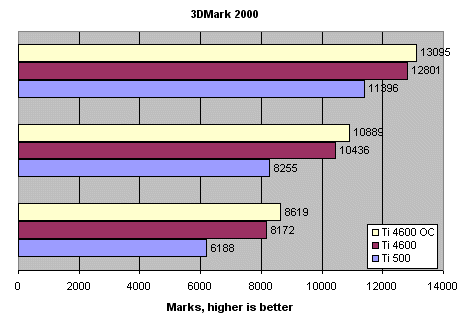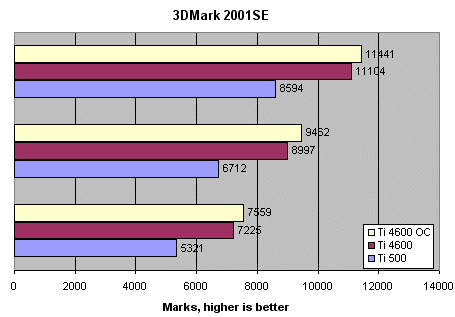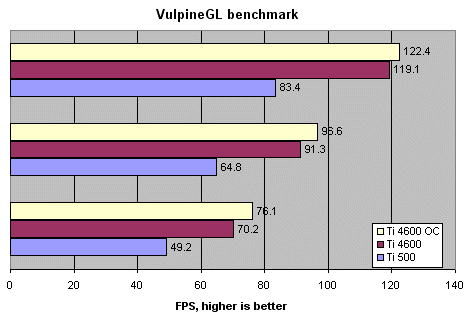Benchmarks I
We'll start off with Madonion's DX7 compliant 3DMark 2000. This should give us an idea of how the MSI Ti 4600 handles games that are available today. We've previously noted that older video cards are usually able to keep some sort of parity with the newest card in town, mainly due to the lack of specialised features on offer. We'll be conducting tests at 1024x768x32, 1280x768x32, and 1600x1200x32. This should give you an idea of how the MSI GF4Ti4600-VTD reacts to differing resolutions.

We start off with 1024x768x16 at the top, 3DMark 2000's native benchmarking resolution, and carry on to 1280x1024x32 in the middle and 1600x1200x32 at the bottom. The Geforce3 Ti 500 does well at 1024x768x16 but soon gets hurt as we raise the resolution. The MSI Ti 4600's greater basic speed and more efficient use of bandwidth is on show here, impressive.
Let's now see what 3DMark 2001SE, the latest incarnation of the popular benchmark, thinks of our cards. We'll use the same format here.

The dual vertex shading ability of the MSI Ti 4600 pays dividends here in no uncertain terms. The dragothic test is heavily vertex shader dependant. More than doubling your capacity reaps rich rewards.
Overclocking the MSI does very little until the card becomes the bottleneck at higher resolutions. At 1024x768x32, it is simply waiting for the CPU to feed it more geometry. The aspect to note is that the MSI Ti 4600 is not just a little faster than the Ti 500, it completely dominates it at higher resolutions.
Now let's head over to a lovely OpenGL benchmark, VulpineGL. It uses the Geforce3/4's advanced features to run through a complex island scene followed by another complex indoor scene. The sheer number of polygons make it a joy to watch.

Another set of results that clearly spell out the superiority of the Geforce4 Ti4600 design. 1600x1200x32 now looks extremely smooth. Another impressive showing of brute force and improved bandwidth efficiency.









